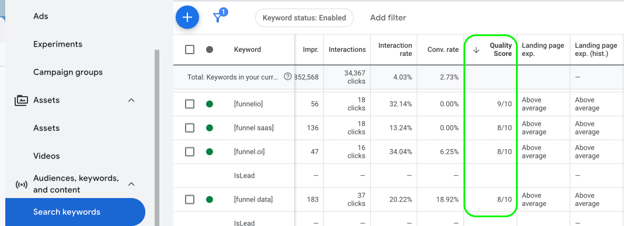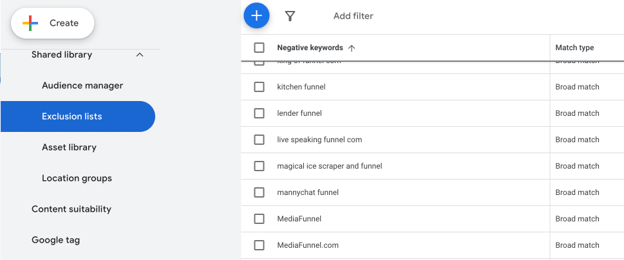-
 Written by Sean Dougherty
Written by Sean DoughertySenior Brand Creative at Funnel, Sean has more than 15 years of experience working in branding and advertising (both agency and client side). He's also a professional voice actor.
Imagine this — your Google Ads campaigns have been running for a while. Traffic is coming to your website, you have seen conversions coming in, and all is good. Well, until it isn't. Suddenly, your conversions drop, cost per acquisition is way up, and your return on ad spend is down. What do you do?
Suppose this is less of an imaginary situation and more of an issue that you currently relate to. In that case, there are actions you can take to diagnose Google Ads performance issues and actively correct them.
Here are six steps to determine what caused the sudden drop in performance and fix it so that you can access accurate data for greater data-driven insight. The longer you stay in the dark, the less effective your data becomes. So, let’s jump in.
Check these things inside your Google Ads account first
To identify the problem, start by looking at the following data inside Google Ads:
1. Conversion tracking
If you are running a new campaign, you will see a very low spend — or next to nothing — if you don't have any tracking and are optimizing for conversions. In contrast, if it's a running campaign where you suddenly see your spending drop, it could mean your conversion tracking is broken. You'd be surprised, but this happens relatively often, so it should be your first step when diagnosing Google Ads performance concerns.
If you've owned your GA account for some time, you might notice differences in performance due to seasonality, changes in targeting, or conversion tracking not working. The easiest thing to do is to check your conversion by day. If, for example, you got 100 conversions yesterday and today you get zero, then there's probably something wrong with your conversion tracking.
2. Quality score
Your quality score can paint a picture following a sudden drop in Google Ad impressions. This score is based on landing page experience, keyword quality score, ad relevance, and the expected click-through rate (CTR). For example, to improve the relevance of a landing page, you should ensure the CTA on your ad aligns with the offer your client sees when they visit the page.

Generally speaking, the higher your quality score, the lower your cost per conversion. You'll want to remain mindful of this data and the influence of Google's auction system. Explore search impression reports to see which factors may lead to a drop in impressions.
3. Negative keywords
Negative keywords are an excellent tool that can help you funnel traffic into relevant campaigns. By eliminating specific searches, you won't have to pay to advertise to people with zero intent of buying from you. For example, at Funnel, we’ve excluded the search term kitchen funnel and other companies that may have the word funnel in their name.

After reviewing some potential issues outlined above, you will hopefully understand what caused the performance decline. Fixing the issue may be obvious, but if it isn't, you must look beyond Google Ads data.
Related: The Best Practices for Google Performance Max
Factors outside of your Google Ads campaigns that may play a role
4. Did the search volume for your keywords change?
If you see fewer impressions, but the campaign didn't change, perhaps the search volume changed? You can check this with the Google Ads keyword search volume tool or a similar external tool. One common example is performance drops related to keywords that capitalize on trends. If specific keywords helped your ad go viral, the opposite could result once interest drops. Another example is seasonal data-related factors that affect Google search trends.
5. Were changes made to the landing pages?
Landing page experience is imperative for conversion optimization. A poorly optimized landing page could sink the entire strategy even when your campaigns are perfectly planned and executed.
Some important questions to ask include:
- Is the speed of your landing page fast enough?
- Do your landing pages use a responsive layout?
- Is your message clear?
- Can users access the landing page from varying devices?
- Did you include a relevant CTA?
- Is it competitive enough concerning offers, prices, and unique selling propositions?
Even if you have positive answers to these questions, you can still experience a performance drop when making a campaign more targeted. Did you change keywords and ad copy to focus on a more specific audience but didn't change your landing page? If your landing page isn't relevant, it can lead to lower ad ranking and conversion rates.
6. Are you offering fewer products?
Picture this — you create dynamic search ads based on all website product categories. In total, there are twelve categories. Then, without your knowledge, the company focuses on only three product categories. These changes can immediately impact performance, especially if one or more removed categories previously contributed to high performance.
If you are getting low traffic to your website, Google recommends adjusting your cost-per-action (CPA) targets and budgets and following the recommendations page in your Google Ads account. Sounds easy, right?
Let's look at general guidelines to change a bad situation where your search ads aren't performing well to where you're now meeting your business goals. Here is a list of the most common tips to get things moving in the right direction.
Adjust your bid targets and optimization goals
The first questions to ask or perhaps revisit is the following — what are your business goals, and what are you trying to achieve with your campaigns? Do you want to increase sales, profits, leads, and transactions? Or do you want to increase website visitors or increase brand awareness?
Knowing the answers to such questions will allow you to adjust your targeting and bidding strategies more effectively. Bidding strategies will vary depending on the campaign type. For example, if you’re focusing on conversions, Smart Bidding takes the guesswork out of the process.
Increase impression share
You can also work on increasing your impression share for greater visibility. By looking at your lost Search Impression Share (ad rank), you can help identify the percentage of time your ads weren't shown on the Search Network due to your ad rank in the auction.
Focus on improving your ad quality and bid adjustments to turn things around. Remember that your budget controls how often an ad is shown — tweaking your budget can increase the percentage of total impressions for your ad.
Broaden your targeting
This suggestion will depend on your strategy. A good rule of thumb is to find the right balance between relevance and volume. You might not get enough traffic if you are too specific with your keywords. However, you might not generate quality traffic if you are too general or generic.
It's about finding the best mix of long-tail keywords with more generic ones. You can start with specific keywords, but add more with higher search volumes later.
Note that with display ads, this shouldn't be as big an issue because you can broaden your targeting to generate more visibility and sales with fewer hiccups.
Ensure that your targeting doesn't overlap with other campaigns or ad groups
If you have the same keyword in multiple campaigns, it can negatively impact performance.
It depends on the type of business — for example, if you are an e-commerce company, it becomes harder to manage when you have a lot of keywords for search campaigns. If you are a smaller business offering one product, it becomes more apparent when you have the same keyword in different campaigns.
In shopping campaigns, there are ways to control which campaign gets the most exposure, and it's much easier to manage any potential overlap. For example, you can use inventory filtering, assigning specific labels to specific products, and then you can also use campaign prioritization, which applies to standard shopping campaigns.
Increase your ad quality score
If your ad copy is terrible, and your keyword doesn't reflect the content on your landing page, you'll get a lousy quality score, and Google will charge you extra for this. However, if your ad copy is good, and the keyword is relevant to the copy on your landing page, you will get a higher quality score.
Ultimately, the rule of thumb here is that the more relevant it is for the user, the better your Google Ads will perform.
Adjust your bidding and budget depending on new auction dynamics
How you work with your bidding and budget can depend on macroeconomic conditions.
For example, during the global pandemic of 2020 and 2021, e-commerce companies were booming, and e-commerce spending was at an all-time.
Now, post-pandemic, e-commerce spending has started to return to normal levels. Seasonality is another aspect to consider. Depending on your business type, you'll want to increase your visibility based on specific consumer behaviors or trends. For example, if you are a company selling gardening equipment, you'll probably want to expand your impression share as the warmer weather and springtime approaches.
Consolidate campaign structure if possible
You can segment campaigns in infinite ways based on audience, intent, keywords, etc. However, this degree of segmentation may not be necessary — simpler may be better for performance based on machine learning. Google continues incorporating greater automation capabilities, allowing users to use real-time auction bids designed to hit specific goals.
When you consolidate your campaign structure, you’ll run fewer campaigns with larger ad groups. As you consolidate match types, you also consolidate traffic and the associated data. When implementing the right tools, this can make it much easier to optimize campaigns.
Improve your landing pages
Boosting your Google Ads campaign performance also involves optimizing landing pages. A well-crafted, user-friendly landing page can increase conversion rates and lead to better results. Ensure your landing page is relevant to your ad copy, has a clear call-to-action, loads quickly, and is mobile-responsive. Regularly analyze and test your landing pages to identify improvements and maximize your advertising return on investment.
-
 Written by Sean Dougherty
Written by Sean DoughertySenior Brand Creative at Funnel, Sean has more than 15 years of experience working in branding and advertising (both agency and client side). He's also a professional voice actor.
